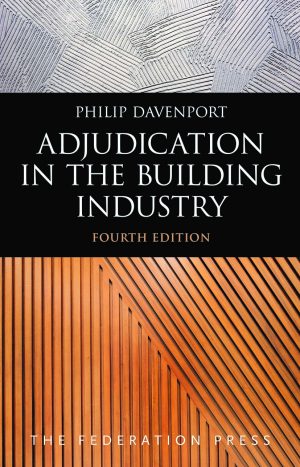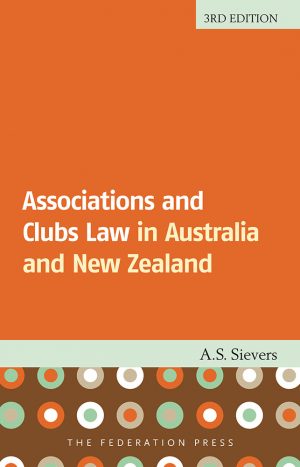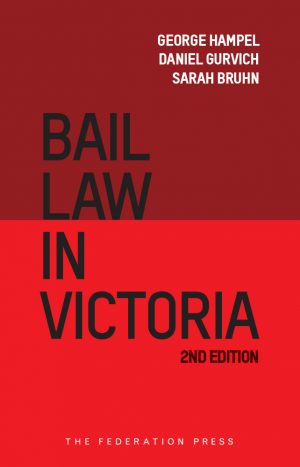Constructing a building is a complex legal as well as technical project. Consequently, architectural and engineering practice increasingly demands a sound understanding of planning and commercial law issues.
Architects, Engineers and the Law has become the standard reference for architects, engineers and lawyers on the legal aspects of day-to-day architectural and engineering practice. J R Cooke provides clear concise explanations of the legal responsibilities of architects and engineers, and the consequences of the many legal processes and relationships part of the construction process.
Twenty-six chapters cover
- Contracts
- Tenders
- Employment relationships
- Budgets and estimates
- Progress certificates
- Statutory planning and building control
- Restrictions on land use
- Consent authorities and planning appeal tribunals
- Moral rights legislation
- Standards of professional conduct and care
- Consequences of breaches of professional duty and care.
Architects, Engineers and the Law will enable you to proceed confident that you understand the legal responsibilities and consequences of your practice.
The Legal System
The Common Law and Equity/ The Sources of the Law/ Interpreting Legislation/ Precedents/ Recent Developments
Contracts
The Formation of the Contract: Simple Contracts and Deeds/ Legislation/ The Terms of the Contract/ Waiver and Estoppel/ Quasi-Contract, Restitution and Unjust Enrichment
Liability Apart from Contract
Criminal Negligence/ Equitable Estoppel (Restitution)/ Trade Practices Act 1974 (Cth), ss 52 and 53 and Fair Trading Acts/ Occupational Health and Safety/ Liability in Tort
Duty of Care
The Standard of Professional Skill / Establishing a Duty of Care/ Professional Indemnity Insurance
Breach of Duty of Care
Introduction/ General Principles/ Existing Knowledge/ Disclosure/ Performance/ Contributory Negligence
Agency and Employment
Agency/ Employment
Damages
Policy/ Damages in Contract/ Damages in Tort/ Examples
Limitations of Actions
Policy/ When Does the Limitation Period Begin?
Concurrent Liability
Introduction/ Limitation Period/ Proof of Breach/ Measure of Damages
Defamation
Introduction/ What is Defamatory?/ The Defences
Intellectual Property
Copyright/ Licence to Build/ Moral Rights
Professional Conduct
Professional Standards/ Trade Practices/ The Impact of the Legislation/ Consumerism
Delegation of Design
Introduction/ Appointment of Consultants/ Design Input from Other Sources
Budgets and Estimates
Background/ Professional responsibilities
Construction Contracts
Types of Contract/ Forms of Contracts
Construction Management
The Traditional System/ Construction Management/ Project Management
Contract Documentation
Introduction/ The Formation of the Contract/ The Tender Documents/ The Execution of the Contract/ Discrepancies in the Documents/ The Specification/ Writing the Specification/ Calling for Tenders on Partial Documentation
Tenders
Introduction/ Calling for Tenders/ From Tender to Contract/ Assessing the Tenders/ Exceeding the Budget
Liquidated Damages and Securities
Liquidated Damages/ Retention and Securities
Variations
Limits of variations/ Administration
Progress Certificates
Introduction/ Certificates Based on Defective Work/ Under Certifying and Over Certifying/ Set-offs and Deductions/ Paying for Unfixed Materials on or off the Site/ Issuing the Certificate/ Valuations and Certificates provided under Partial Services Agreements/ Security of Payment Legislation
Completion and Effects
Introduction/ Extensions of Time/ Practical Completion/ Defects Liability/ The Final Certificate
Determining the Contract
Introduction/ Service of Notice/ Wrongful Repudiation of Contract/ Use of Contractor’s Plant and Equipment/ Expenditure of Retention Moneys after Determination
Non-Statutory Restrictions on Land Use
Land Ownership and Related Restrictions on Land Use/ Common Law Rights of Landowners
Statutory Planning and Building Control
Background/ Building Regulations / Environmental Protection Legislation and Conditions of Approval/ Planning Control/ Law and Urban Design
Consent Authorities and Planning Appeal Tribunals
Obligations of Architects and Engineers in Dealing with Consent Authorities/ Negligence by Consent Authorities/ Review of Administrative Action of Consent Authorities/ Appeals
Table of Cases/ Table of Statutes/ Bibliography/ Index
Reviews of the previous editions:
This, the third edition, by a very well qualified author, is a book every architect or engineer should have on their desk. …
Although it is a text book with all the appropriate legal references, it is written in a very ‘readable’ way making complicated subjects such as torts, estoppel, defamation, and ‘accidental aesthetic consequences’ more understandable for the untrained than I have read before.
It covers all that would seem to be in the horizon of professional practise. … All the great cases are there …
What is excellent is the set out of all the types of contract that a builder can use and the explanation of variations, damages, tenders and construction management.
Australian Building News
Cooke is a solicitor, who is an architecture graduate of the University of Sydney as well as a law graduate of the University of New South Wales. In addition he has a Master degree in Building from the University of New South Wales and a PhD in Architecture in the field of land use and planning from the University of Sydney. …
[His book] is written for architects, and to a lesser extent for engineers …
This is mainly a book for architects on how to deal with the law. But there are some interesting asides. Dr Cooke discusses, for example, the fights which architects have had with building regulations, and he cites cases fought by Gropius, Sydney Ancher, and Harry Seidler, and the arguments advanced against detailed regulations by Walter Bunning and Robin Boyd.
Architectural Science Review, Vol 44(4)
[T]he latter chapters (11 onwards) may be of great value to lawyers as they try to advise such professionals [engineers and architects]. They draw together a great number of cases involving building or engineering disputes.
It is not meant to be and is not therefore a substitute for detailed research by a lawyer, but it is a mighty good first step to identifying how one should research. So whilst it is fundamentally a book for engineers and architects, I suspect that it also has a home in legal libaries …
Law Society of Tasmania Newsletter, October 2001
When I commenced ro read the book, I was negative towards it, thinking it would be no more than a non-lawyers book … But the book is much more than that. In the first place there are the remarkable qualifications of the author, Dr Cooke, who hold bachelors degrees in architecture and law, a masters degree in building science and a doctorate in architecture. … The scope of the book is ambitious: it commences with an introduction to the legal system, and then proceeds to touch upon a remarkably diverse group of subjects …
[I]t is very detailed which is obviously the product of an enormous amount of research. …
For the general lawyer I would hesitate before recommending Dr Cooke’s book, but it is not possible to simply dismiss it, as it does constitute, at least for a person interested in construction law, an invaluable list of decisions with a construction bent. This is especially so in the second half of the book, much of which deals with specialist matters relating to particular building contracts – the interpretation of particular clauses and so forth.
Bar News (NSW Bar Association Journal), Summer 2001/2002
Architects, Engineers and the Law (3rd edition) is a useful and concise summary of law and legal developments in the field broadly referred to as ‘construction law’. While aimed primarily at architects, engineers and other construction industry professionals, the text is also of great practical value for the practising construction lawyer or student.
…
[It] is an excellent legal handbook for the professional doing business in the construction industry.
Australian Construction Law Bulletin, Vol 13(10), January 2002
This practical guide … provides a clear, concise and readily accessible overview of many aspects of the law surrounding the day-to-day practice of the disciplines of architecture and engineering. …
Overall, the text is well balanced and, as the author suggests, avoids a “… misleadingly superficial picture … [of the law] … while at the same time not attempting to examine every legal technicality”. …
As a stand-alone text for those engaged in the everyday work of architects and engineers, this book will undoubtedly prove most useful. Certainly, it will also be welcomed for its straightforward and “hands on” approach to the law and its implications for practitioners in both professions.
… [It] deserves to be widely and enthusiastically embraced.”
Law Institute Journal (Victoria), February 2002
[T]he author provides clear and concise explanations of the legal responsibilities of architects and engineers, the consequences of the many legal processes and relationships which form part of the construction process.
What is particularly useful about the book is that each chapter commences with a section headed “further reading”, which identifies relevant chapters of appropriate further reading material.
…
The book is best suited to those professionals who lack experience of construction contracts or indeed construction law. The book does appear from the outset to be user-friendly.
…
Probably one of the longer and more important chapters in the book is that on contract documentation (Ch 17). The chapter deals with the formation of the contract, the tender documents, execution of the contract and the specification. Usefully, the chapter identifies arrangements which should be avoided and the difficulties which may be encountered by architects and engineers.
Building and Construction Law Journal, Vol 18, June 2002
Architects, Engineers and the Law succeeds in bridging the technical building sciences and the legal profession. I find I use the book on a regular basis when conducting building and construction litigation.
It contains 26 brief chapters which cover the complete ambit of building and construction law. It commences with a brief introduction to the Australian legal system, then provides vital information on contracts, concurrent liability, the relationships of agency and employment, construction management, the functions of local councils and many other important topics.
JR Cooke has impeccable credentials. His expertise in this branch of law and in the technical sciences has resulted in a text of great value, enhanced by many references and suggestions for further reading.
Law Society Journal (NSW), July 2002






